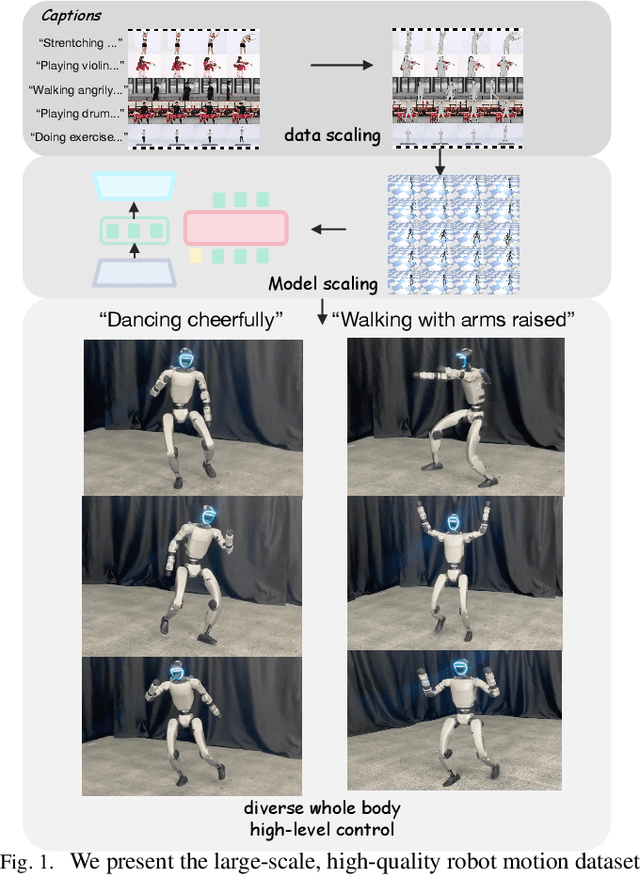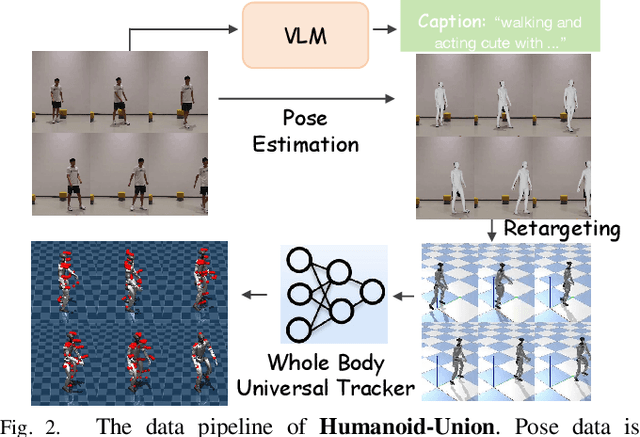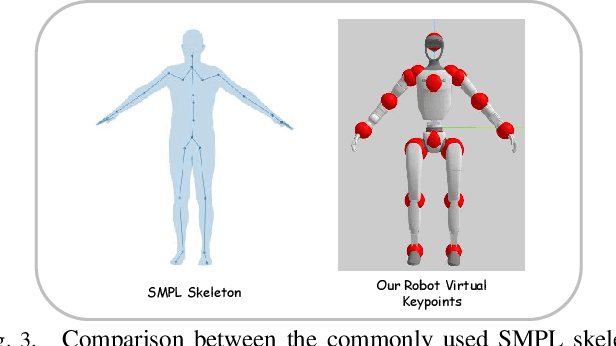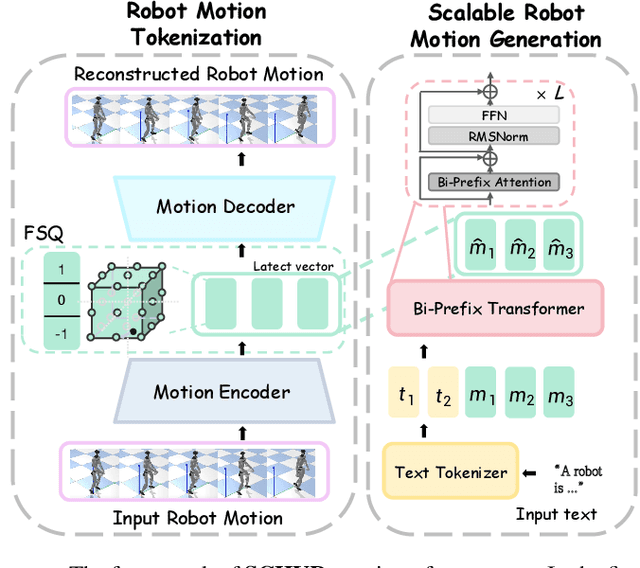Jingbo Wang
EgoReAct: Egocentric Video-Driven 3D Human Reaction Generation
Dec 28, 2025Abstract:Humans exhibit adaptive, context-sensitive responses to egocentric visual input. However, faithfully modeling such reactions from egocentric video remains challenging due to the dual requirements of strictly causal generation and precise 3D spatial alignment. To tackle this problem, we first construct the Human Reaction Dataset (HRD) to address data scarcity and misalignment by building a spatially aligned egocentric video-reaction dataset, as existing datasets (e.g., ViMo) suffer from significant spatial inconsistency between the egocentric video and reaction motion, e.g., dynamically moving motions are always paired with fixed-camera videos. Leveraging HRD, we present EgoReAct, the first autoregressive framework that generates 3D-aligned human reaction motions from egocentric video streams in real-time. We first compress the reaction motion into a compact yet expressive latent space via a Vector Quantised-Variational AutoEncoder and then train a Generative Pre-trained Transformer for reaction generation from the visual input. EgoReAct incorporates 3D dynamic features, i.e., metric depth, and head dynamics during the generation, which effectively enhance spatial grounding. Extensive experiments demonstrate that EgoReAct achieves remarkably higher realism, spatial consistency, and generation efficiency compared with prior methods, while maintaining strict causality during generation. We will release code, models, and data upon acceptance.
Learning Generalizable Hand-Object Tracking from Synthetic Demonstrations
Dec 22, 2025Abstract:We present a system for learning generalizable hand-object tracking controllers purely from synthetic data, without requiring any human demonstrations. Our approach makes two key contributions: (1) HOP, a Hand-Object Planner, which can synthesize diverse hand-object trajectories; and (2) HOT, a Hand-Object Tracker that bridges synthetic-to-physical transfer through reinforcement learning and interaction imitation learning, delivering a generalizable controller conditioned on target hand-object states. Our method extends to diverse object shapes and hand morphologies. Through extensive evaluations, we show that our approach enables dexterous hands to track challenging, long-horizon sequences including object re-arrangement and agile in-hand reorientation. These results represent a significant step toward scalable foundation controllers for manipulation that can learn entirely from synthetic data, breaking the data bottleneck that has long constrained progress in dexterous manipulation.
Maritime object classification with SAR imagery using quantum kernel methods
Dec 12, 2025Abstract:Illegal, unreported, and unregulated (IUU) fishing causes global economic losses of \$10-25 billion annually and undermines marine sustainability and governance. Synthetic Aperture Radar (SAR) provides reliable maritime surveillance under all weather and lighting conditions, but classifying small maritime objects in SAR imagery remains challenging. We investigate quantum machine learning for this task, focusing on Quantum Kernel Methods (QKMs) applied to real and complex SAR chips extracted from the SARFish dataset. We tackle two binary classification problems, the first for distinguishing vessels from non-vessels, and the second for distinguishing fishing vessels from other types of vessels. We compare QKMs applied to real and complex SAR chips against classical Laplacian, RBF, and linear kernels applied to real SAR chips. Using noiseless numerical simulations of the quantum kernels, we find that QKMs are capable of obtaining equal or better performance than the classical kernel on these tasks in the best case, but do not demonstrate a clear advantage for the complex SAR data. This work presents the first application of QKMs to maritime classification in SAR imagery and offers insight into the potential and current limitations of quantum-enhanced learning for maritime surveillance.
Gallant: Voxel Grid-based Humanoid Locomotion and Local-navigation across 3D Constrained Terrains
Nov 18, 2025Abstract:Robust humanoid locomotion requires accurate and globally consistent perception of the surrounding 3D environment. However, existing perception modules, mainly based on depth images or elevation maps, offer only partial and locally flattened views of the environment, failing to capture the full 3D structure. This paper presents Gallant, a voxel-grid-based framework for humanoid locomotion and local navigation in 3D constrained terrains. It leverages voxelized LiDAR data as a lightweight and structured perceptual representation, and employs a z-grouped 2D CNN to map this representation to the control policy, enabling fully end-to-end optimization. A high-fidelity LiDAR simulation that dynamically generates realistic observations is developed to support scalable, LiDAR-based training and ensure sim-to-real consistency. Experimental results show that Gallant's broader perceptual coverage facilitates the use of a single policy that goes beyond the limitations of previous methods confined to ground-level obstacles, extending to lateral clutter, overhead constraints, multi-level structures, and narrow passages. Gallant also firstly achieves near 100% success rates in challenging scenarios such as stair climbing and stepping onto elevated platforms through improved end-to-end optimization.
Unveiling the Impact of Data and Model Scaling on High-Level Control for Humanoid Robots
Nov 12, 2025



Abstract:Data scaling has long remained a critical bottleneck in robot learning. For humanoid robots, human videos and motion data are abundant and widely available, offering a free and large-scale data source. Besides, the semantics related to the motions enable modality alignment and high-level robot control learning. However, how to effectively mine raw video, extract robot-learnable representations, and leverage them for scalable learning remains an open problem. To address this, we introduce Humanoid-Union, a large-scale dataset generated through an autonomous pipeline, comprising over 260 hours of diverse, high-quality humanoid robot motion data with semantic annotations derived from human motion videos. The dataset can be further expanded via the same pipeline. Building on this data resource, we propose SCHUR, a scalable learning framework designed to explore the impact of large-scale data on high-level control in humanoid robots. Experimental results demonstrate that SCHUR achieves high robot motion generation quality and strong text-motion alignment under data and model scaling, with 37\% reconstruction improvement under MPJPE and 25\% alignment improvement under FID comparing with previous methods. Its effectiveness is further validated through deployment in real-world humanoid robot.
Towards Adaptable Humanoid Control via Adaptive Motion Tracking
Oct 16, 2025Abstract:Humanoid robots are envisioned to adapt demonstrated motions to diverse real-world conditions while accurately preserving motion patterns. Existing motion prior approaches enable well adaptability with a few motions but often sacrifice imitation accuracy, whereas motion-tracking methods achieve accurate imitation yet require many training motions and a test-time target motion to adapt. To combine their strengths, we introduce AdaMimic, a novel motion tracking algorithm that enables adaptable humanoid control from a single reference motion. To reduce data dependence while ensuring adaptability, our method first creates an augmented dataset by sparsifying the single reference motion into keyframes and applying light editing with minimal physical assumptions. A policy is then initialized by tracking these sparse keyframes to generate dense intermediate motions, and adapters are subsequently trained to adjust tracking speed and refine low-level actions based on the adjustment, enabling flexible time warping that further improves imitation accuracy and adaptability. We validate these significant improvements in our approach in both simulation and the real-world Unitree G1 humanoid robot in multiple tasks across a wide range of adaptation conditions. Videos and code are available at https://taohuang13.github.io/adamimic.github.io/.
LLM Based Bayesian Optimization for Prompt Search
Oct 05, 2025



Abstract:Bayesian Optimization (BO) has been widely used to efficiently optimize expensive black-box functions with limited evaluations. In this paper, we investigate the use of BO for prompt engineering to enhance text classification with Large Language Models (LLMs). We employ an LLM-powered Gaussian Process (GP) as the surrogate model to estimate the performance of different prompt candidates. These candidates are generated by an LLM through the expansion of a set of seed prompts and are subsequently evaluated using an Upper Confidence Bound (UCB) acquisition function in conjunction with the GP posterior. The optimization process iteratively refines the prompts based on a subset of the data, aiming to improve classification accuracy while reducing the number of API calls by leveraging the prediction uncertainty of the LLM-based GP. The proposed BO-LLM algorithm is evaluated on two datasets, and its advantages are discussed in detail in this paper.
DHAGrasp: Synthesizing Affordance-Aware Dual-Hand Grasps with Text Instructions
Sep 26, 2025Abstract:Learning to generate dual-hand grasps that respect object semantics is essential for robust hand-object interaction but remains largely underexplored due to dataset scarcity. Existing grasp datasets predominantly focus on single-hand interactions and contain only limited semantic part annotations. To address these challenges, we introduce a pipeline, SymOpt, that constructs a large-scale dual-hand grasp dataset by leveraging existing single-hand datasets and exploiting object and hand symmetries. Building on this, we propose a text-guided dual-hand grasp generator, DHAGrasp, that synthesizes Dual-Hand Affordance-aware Grasps for unseen objects. Our approach incorporates a novel dual-hand affordance representation and follows a two-stage design, which enables effective learning from a small set of segmented training objects while scaling to a much larger pool of unsegmented data. Extensive experiments demonstrate that our method produces diverse and semantically consistent grasps, outperforming strong baselines in both grasp quality and generalization to unseen objects. The project page is at https://quanzhou-li.github.io/DHAGrasp/.
Motion2Motion: Cross-topology Motion Transfer with Sparse Correspondence
Aug 18, 2025



Abstract:This work studies the challenge of transfer animations between characters whose skeletal topologies differ substantially. While many techniques have advanced retargeting techniques in decades, transfer motions across diverse topologies remains less-explored. The primary obstacle lies in the inherent topological inconsistency between source and target skeletons, which restricts the establishment of straightforward one-to-one bone correspondences. Besides, the current lack of large-scale paired motion datasets spanning different topological structures severely constrains the development of data-driven approaches. To address these limitations, we introduce Motion2Motion, a novel, training-free framework. Simply yet effectively, Motion2Motion works with only one or a few example motions on the target skeleton, by accessing a sparse set of bone correspondences between the source and target skeletons. Through comprehensive qualitative and quantitative evaluations, we demonstrate that Motion2Motion achieves efficient and reliable performance in both similar-skeleton and cross-species skeleton transfer scenarios. The practical utility of our approach is further evidenced by its successful integration in downstream applications and user interfaces, highlighting its potential for industrial applications. Code and data are available at https://lhchen.top/Motion2Motion.
MOSPA: Human Motion Generation Driven by Spatial Audio
Jul 16, 2025Abstract:Enabling virtual humans to dynamically and realistically respond to diverse auditory stimuli remains a key challenge in character animation, demanding the integration of perceptual modeling and motion synthesis. Despite its significance, this task remains largely unexplored. Most previous works have primarily focused on mapping modalities like speech, audio, and music to generate human motion. As of yet, these models typically overlook the impact of spatial features encoded in spatial audio signals on human motion. To bridge this gap and enable high-quality modeling of human movements in response to spatial audio, we introduce the first comprehensive Spatial Audio-Driven Human Motion (SAM) dataset, which contains diverse and high-quality spatial audio and motion data. For benchmarking, we develop a simple yet effective diffusion-based generative framework for human MOtion generation driven by SPatial Audio, termed MOSPA, which faithfully captures the relationship between body motion and spatial audio through an effective fusion mechanism. Once trained, MOSPA could generate diverse realistic human motions conditioned on varying spatial audio inputs. We perform a thorough investigation of the proposed dataset and conduct extensive experiments for benchmarking, where our method achieves state-of-the-art performance on this task. Our model and dataset will be open-sourced upon acceptance. Please refer to our supplementary video for more details.
 Add to Chrome
Add to Chrome Add to Firefox
Add to Firefox Add to Edge
Add to Edge